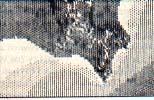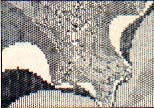Product Reviews
Clash: Ethereal, Star NR-10
CLASH: ETHEREAL
In the mood for a quick trip to Hades? No, I'm not venturing into the travel agent business. Rather, I'm describing a game in which you'll battle Satan himself in a fight to save your soul. In Clash: Ethereal there are magic stones to find, clues to gather, traps to avoid and fully animated foes to battle. There are five different dungeons, making up 95 distinct screens. But to win, you must solve 13 riddles.
You won't solve them all in one sitting, but it is possible to save the game at any of several points. The graphics are adequate, but not prize-winning. Movement can be accomplished via the keyboard (with or without a joystick). Overall, the challenge should keep you entertained for quite a while, and the quality of the system is high enough to make Clash: Ethereal worth the cost.--RICK TEVERBAUGH
$17.95, 48K disk. Imagists Group, 9721 Ashbourn Drive, Burke, VA 22015. (703) 764-0835.
STAR NR-10
Reviewed br Gregg Pearlman
The fast, feature-laden Star NR-10 can be considered the top-of-the-line Star Micronics 9-pin dot-matrix printer. Look at the speed comparison chart (figure 1) and you'll see that the NR-10 left Antic's other dot-matrix printers in the dust. The NR-10 printed a document of exactly 20,000 characters at 148 characters per second (cps) in 10-pitch and 40 cps in near letter quality (NLQ).
| PRINT SPEED COMPARISON | |
|---|---|
| (10-pitch, draft mode) | |
| Printer | cps |
| Star NR-10 | 148 |
| Panasonic KXP-1080i | 83 |
| Okidata 180 | 83 |
| Star NL-10 | 75 |
| Atari SMM804 | 61 |
| Atari XMM801 | 51 |
Draft quality text on the NR-10 looks about the same as on Star NL and NX series printers--clear and readable in 10, 12 and 17.1 characters per inch (cpi). However, the NLV in 10 cpi probably looks better than that other nine-pin dot-matrix at Antic--less obviously "made of dots." It's still near letter quality but I'd say it's adequate for business correspondence when printing with a dark new ribbon. I'd also say that the NLQ is even better in 12-pitch (12 cpi) than l0-pitch.
The NR-10 supports boldface, enhanced print, italics, underlining, subscript, superscript and double-wide printing. It even boasts a "master print mode" which allows you, in one simple escape code, to mix and match among eight print styles. (Other Star printers such as the NL-10 have this feature too.) Special features include 11 types of international characters, double-sized and quad-sized printing and macro definition.
There's also a proportional 10-pitch setting. (Divide cpl by 8 to get cpi.) The NR-10 panel buttons feature draft and NLQ settings for 80, 96 and 137 characters per line (cpl) although you can't get 137 cpl NLQ. The master print mode somewhat frees you of these boundaries, however. You can combine proportional print with all three print pitches through BASIC or a word processing program that allows user-defined printer codes such as First XLEnt Word Processor or, to a lesser extent, PaperClip. Depending on what settings you might choose in the master print mode, your text could be between 5 and 20 cpi.
 |
 |
 |
 |
The NR-10 yields nice, dark text, but graphics printouts aren't particularly sharp, dark or clear, even with a new ribbon. The NR-10's graphics printouts, while fast, aren't as good as those on the less expensive Panasonic KXP-1080i and Okidata 180 (reviewed in Antic, April 1988).
When hooked up to an ST, [ALT] [HELP] screen dumps including the ST desktop and game screens took around 85 seconds to print. Screen dumps printed from within DEGAS Elite took between 81 seconds and 106 seconds, depending on how much white space the picture had.
The NR-10 is easy to hook up. The standard Centronics parallel port connects directly to an ST, and is easy enough to connect to an 8-bit Atari via the ICD P:R: Connection or Atari 850 interface. The NR-10 is reasonably quiet, yields good looking draft and near letter quality (NLQ) printouts.
On a noise scale of 1 to 10, with 1 being silent and 10 being a daisywheel printer, the NR-10 would rate about 4--you could hold a conversation over the drone of this printer with reasonable comfort. It's a bit quieter than our Star NL-10 (Antic, January 1988), considerably quieter than the Panasonic KXP-1080i, and somewhat louder than the Okidata 180, at least when printing text.
The documentation for the NR-10 runs 233 pages--consisting of eight chapters, seven appendices and an index. Also enclosed is a leaflet titled "Utilizing Star's Technical Support Services," a "Users' Guide" card that discusses the panel switch combinations, self-tests, ribbon installation and automatic paper loading, and a sticker to be placed next to the control panel as a guide to selecting special features on the NR-10.
The appendices occupy about 4O% of the manual and cover DIP switch settings, ASCII codes and conversions, function code command summary, technical specifications, a discussion of the parallel interface, and serial interface specifications.
If you can get the Star NR-10 for $300, snap it up. If you can get it at $400, you're still in good shape. And even at its top-of-the-line $579 suggested retail price, the NR-10 still merits serious consideration if speed and outstanding NLQ text are sufficiently important to you.
$579. Star Micronics, Inc., 3 Oldfield, Irvine, CA 92718. (800) 537-8270.